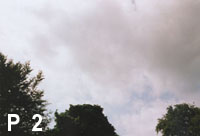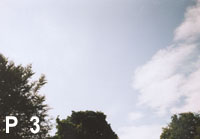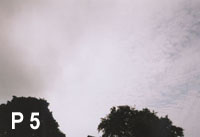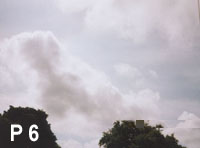
Llansadwrn (Anglesey) Weather Station:
Observations during the solar eclipse on 11 August 1999.


| Llansadwrn (Anglesey) Weather Station: |

|
The eclipse of the sun is a rare event that gives an opportunity, for weather enthusiasts, to make observations of some unusual effects at their station.
The eclipse of 29 June 1927 gave people in North Wales and northern England the chance to view its totality, but the event was spoiled by cloudy skies. The eclipse in 1999 gave people living in Cornwall the chance of seeing the total eclipse (Fig. 1) but the weather again spoiled the view. On Anglesey there was a partial eclipse and, though cloudy at times, conditions allowed the event to be an experience worth observing and recording (Perkins 2000).
These pages present some additional information and photographs of the cloud formations not previously published.
Return to top of page
![Llansadwrn: Fig.1 Track and timing of the eclipse on 11 August 1999 [39KB]. Llansadwrn: Fig.1 Track and timing of the eclipse on 11 August 1999 [39KB].](graphics/ec_fig1.jpg) |
![Llansadwrn: Fig. 2 WEATHER LOG map for 12 GMT on 11 August 1999 [40KB]. Llansadwrn: Fig. 2 WEATHER LOG map for 12 GMT on 11 August 1999 [40KB].](graphics/ec_fig2.jpg)
|
|
Weather on 11 August 1999 
The mornings of the 3 previous days had 8 oktas cloud cover with rain. During the afternoon of the 10th a weak ridge of high pressure moved eastwards. By the evening there was an almost clear sky and hopes were raised that the 11th would be clear. Although there was an area of high pressure in the Atlantic (Fig. 2) there was a depression to the SW of Ireland (1016 mb) and a trough was moving in over SW England. This gave almost total cloud cover for those viewing the totality in the SW. The 11th was bright and sunny at 0800 GMT on Anglesey (Photo 1) and, although it became cloudier, some interesting observations were made during the event. |
The following is an account transcribed from notes made at the time of the eclipse.
All times are GMT. Photographs are looking S with the sun to the left of the frame. .
0600: Patchy high altocumulus clouds (2 oktas) and cirrus (4 oktas). Wind N'ly f1. Bright and sunny. Visibility good with slight haze.
0700: Sky clearing. Cloud low to the SW and patchy cirrus to the S-SE (2 oktas).
0800: High thin cirrus (4 oktas) with lower patch of broken altocumulus overhead (2 oktas), cirrostratus to S and W (4 oktas), Overall cloud estimate 6 oktas. Wind NE'ly f1. Sunny. Visibility good with slight haze.
0900: The cirrostratus has increased (6 oktas) and patches of cumulus have formed (3 oktas). Overall estimate 6 oktas. Wind now S'ly f2. Bright and generally sunny. Visibility good with slight haze.
0902: First contact.
0930: Cloud now 7 oktas overall. Wind now S'ly f2. The sun is clearly visible through the thin cloud showing 20% eclipsed.
 0945: Cumulus clouds have appeared, some are quite dark, and are now dominant (Photo 2).
0945: Cumulus clouds have appeared, some are quite dark, and are now dominant (Photo 2).
0950: Sun is visible and about 50% eclipsed.
0955: Cumulus have begun to disperse (3 oktas), sun is clear again except for thin cirrus (6 oktas) (Photo 3).
 1000: Sun more or less in the clear except for cirrus.
1000: Sun more or less in the clear except for cirrus.
1010: Sun still more or less in the clear except for cirrus. Some cloud to the W.
1012: Patches of thin remnant cumulus drifting around with cirrus above that looks somewhat thicker. Sun mostly visible through the cloud (6 oktas overall). The wind has dropped and it is calm.
1015: Maximum eclipse 91%. Cloud appears thinner and the sun is clearly visible (still 6 oktas overall). The lower temperature, evident on the instruments, is felt on the skin. The colour of the light has noticeably changed to be a bluish white. Shadows are sharp and distinct especially the fine leaves of plants and a potted spiky leaved Bilbergia. Birds are singing. Not many birds sing at this time of year in the garden, but of those that are (wrens, robins and a blackcap) the singing of these was very noticeable at this time.
 1025: (Photo 4) Clouds (cumulus) are dispersing becoming very broken (altocumulus) and thinner. Wind is now NE'ly less than f1.
1025: (Photo 4) Clouds (cumulus) are dispersing becoming very broken (altocumulus) and thinner. Wind is now NE'ly less than f1.
1033: Cloud is forming again (in situ) overhead possibly as a result of convergence of the cooler NE'ly off the sea and the warmer S/SW. Broken cloud still to the W (7 oktas overall).
 1040: Sun is now almost hidden behind cloud that appears darker in colour (Photo 5).
1040: Sun is now almost hidden behind cloud that appears darker in colour (Photo 5).
1045: The dark recently formed cloud is moving away to the SE leaving thin broken altocumulus and cirrus as before at 1025. (6 oktas). The visibility is still good but it is much more hazy. Wind <1 NE'ly.
1050: Despite the thin cloud it does feel warmer.
1055: Eclipse is on the last 20%.
1100: The altocumulus has drifted more to the SE.
1126: Last contact.
 1135: Cumulus clouds are now quickly reforming (7 oktas).
1135: Cumulus clouds are now quickly reforming (7 oktas).
1200: Cumulus are now well established overhead and can be seen towering over the mountains to the S (Photo 6). Wind light, somewhat variable, but mainly NE'ly.
1440-1450: Slight rain shower but not enough to be measurable.
1500: Overcast (8 oktas). Wind NE'ly F less than f1. Visibility good but with thick haze.
1620: Still cloudy (6 oktas), signs of clearing with sunny spells. Visibility now moderate, thick hazy.
1700: Cloud 7 oktas. Wind NE'ly f1. Visibility poor.
1800: Overcast 8 oktas. Wind NE'ly f1. Visibility poor.
Return to top of page
Near first contact (0902 GMT) a lot more thin cloud including cumulus had formed. By 0945 GMT (Photo 2) this cloud was looking dark in colour and partially obscuring the sun now 50% eclipsed. The cumulus, which had formed, started to disperse (Photo 3) and by 1000 GMT only the cirrus that remained obscured the sun. At this point the cirrus looked darker, or thicker, but this may have been a result of the diminished light. Some remnant cumulus drifted around from time to time but was still dispersing at 1025 GMT when broken and thinning altocumulus was seen (Photo 4). Soon after the S'ly breeze ceased and the NE'ly off the sea returned and cloud began reforming possibly due to convergence of cooler and warmer air (Photo 5). This reformed cloud moved off to the SE leaving thin altocumulus and cirrus much as before. Last contact was at 1126 GMT and cloud reformed (Photo 6) which, by 1200 GMT, was well established and cumulus could be seen towering over the mountains of Snowdonia. There was a slight shower of rain between 1140-1450 GMT. It seems that the eclipse did modify the normal pattern of cumulus development, with the weather type prevalent on 11 August.
See larger versions of the cloud photographs
Return to top of page
|
Solar radiation levels (Fig. 3) were near normal, for the time of year at 0900 GMT, but soon after began to decline as the sun was eclipsed. The minor fluctuations are probably due to varying amounts and thickness of cloud described above. The minimum of 2% of the unobscured reading at 1200 GMT was recorded at the point of maximum partiality at 1015 GMT. The quality of light was noticeably changed, near maximum partiality, to a bluish white colour. Shadows of fine leaved plants appeared sharper but no other effects were seen. Radiation had returned to 90% of normal by 1130 GMT, just past last contact, the sun being obscured by thin reforming cloud. Return to top of page |
![Llansadwrn: Fig.3 Solar radiation received during eclipse [26KB] Llansadwrn: Fig.3 Solar radiation received during eclipse [26KB]](graphics/ec_fig3.jpg) |
![Llansadwrn: Fig. 4 Air temperature and relative humidity during eclipse [25KB] Llansadwrn: Fig. 4 Air temperature and relative humidity during eclipse [25KB]](graphics/ec_fig4.jpg)
|
The temperature in the screen at 0900 GMT was 16.2C and this was to rise to 16.6C at 0915 GMT (Fig. 4). This was 12 min after first contact, thereafter the temperature declined to 14.5C, a fall of 2.1C, by 1040 GMT 25 min after maximum partiality. Relative humidity increased from 76% at 0900 GMT to 90% at 1030 GMT, 15 min after maximum partiality. Return to top of page |
|
The unshielded thermometer at 2 cm above grass (Fig. 5) was reading 19.8C at 0900 GMT and declined to 12.3C by 1020 GMT a fall of 7.5C, only 5 min after maximum partiality, before rising again to reach 25.5C at 1130 GMT. The digital probe exposed at 2.4 m above grass was reading 16.7C at 0900 GMT and declined to 12.5C, 5 min after maximum partiality, a fall of 4.2C before reaching 18.0C by 1130 GMT. Return to top of page |
![Llansadwrn: Fig 5 Temperatures with unshielded thermometers during eclipse [27KB] Llansadwrn: Fig 5 Temperatures with unshielded thermometers during eclipse [27KB]](graphics/ec_fig5.jpg)
|
![Llansadwrn: Fig. 6 Soil temperatures during eclipse [31KB] Llansadwrn: Fig. 6 Soil temperatures during eclipse [31KB]](graphics/ec_fig6.jpg)
|
The temperature at 5-cm depth under bare moist soil at 0900 GMT was 15.2C. This rose to 17.2C at 1000 GMT, nearly 1 h after first contact. A decline to 16.9C had taken place by 1045 GMT and held steady until 1200 GMT. Comparison with temperatures recorded the next day suggested that these temperatures could have been at least 1C below expected in normal radiation. At greater depth smaller differences occurred; 0.6C at 10 cm and 0.3C at 20 cm. Temperatures at greater depths were not markedly affected, it would however need greater computation to assess the effect on the whole soil profile. Return to top of page |
The partial solar eclipse observed at Llansadwrn reduced radiation to an extent that temperatures measured near the ground with standard instruments were reduced. The fall in screen temperature (2.1C), 25 min after maximum partiality, was within the range (3.6-2.0C) previously reported for total eclipses around the world (Anderson 1999). The 2 unshielded thermometers at 2 cm and 2.4 m over grass showed larger but different falls (7.5C and 4.2C respectively). As the eclipse proceeded the difference between these thermometers became less; the minima were only 0.2C different 5 min after maximum partiality. These reduced temperatures were reflected in the comments of observers, in summer clothing, who said they felt colder.
The atmospheric cooling which took place during the eclipse was sufficient to affect cloud development. Weather on the day was such that cumulus clouds would develop during the morning to become dominant around noon and would most likely disperse by evening. The cloud development started but during the eclipse dispersion of cumulus took place. After the eclipse normal development was resumed and there was a slight shower in the afternoon.
The quality of light near maximum partiality was changed. There was a change in colour to a bluish white, several local people commented upon this phenomenon. There also appeared to be a sharpening effect on some shadows, particularly those of fine leaved plants near the ground. Around the time of maximum partiality there was much singing from birds including wrens, robins and a blackcap.
Making an effort to record the effects of the eclipse was worthwhile. I can commend it to other amateur meteorologists if the occasion arises at their station. It is necessary to carefully plan ahead what you can do. Make a list of what instruments it might be useful to use and work out a schedule, not forgetting to allow some time for enjoying the experience. Take photographs at regular intervals, a data recording camera would have been useful, as I had to make a note of the time of each frame. Also I wish that I had set up a camcorder to record the event automatically while I was making the observations. Sadly, the observations will not be repeatable in this locality for some time!
Return to top of page
ANDERSON, J. (1999) Meteorological changes during a solar eclipse. Weather 54 (7), 207-215.
PERKINS, D. F. (2000) Weather observations on Anglesey during the solar eclipse on 11 August 1999. J. Meteorology, U.K. 25 (245), 5-10.
WEATHER LOG map for 11 August 1999. Weather 54(10).
Return to top of page
JONES, BRYN (1999) Local newspaper accounts of the 1927 eclipse in North Wales no longer available online
JONES, BRYN (1999)No longer available on original url
.Return to top of page
Llansadwrn, Anglesey. Observations made on 11 August 1999. Temperatures are in deg C, solar radiation is % of unobscured reading at 12 GMT. GMT Solar Probe Screen RH% Grass Soil 5 10 cm 20 cm 30 cm 50 cm 100 cm 0800 13.9 13.0 13.0 87.2 12.0 13.8 15.0 16.5 17.7 17.9 17.2 0815 18.6 14.8 13.9 84.2 13.0 13.9 15.0 16.5 - - - 0830 46.5 14.9 14.8 72.1 16.0 14.0 15.0 16.5 17.5 - - 0845 62.8 15.8 15.5 76.8 18.6 14.4 15.0 16.5 17.5 - - 0900 74.4 16.7 16.2 76.3 19.8 15.2 15.2 16.5 17.6 17.8 17.2 0915 20.9 16.3 16.6 74.6 18.8 16.0 15.5 16.5 17.7 - - 0930 18.6 15.6 16.5 77.5 18.5 16.7 15.5 16.5 - - - 0945 30.2 15.1 16.2 77.3 17.4 17.0 15.8 16.5 - - - 1000 18.6 14.5 15.8 78.0 15.5 17.2 16.0 16.5 17.5 - - 1015 2.3 13.4 15.4 79.8 13.5 - - - - - - 1020 4.8 12.5 14.7 84.6 12.3 17.1 16.2 16.5 17.5 17.7 17.2 1030 16.3 13.2 14.7 90.0 13.7 17.0 16.4 16.5 - - - 1035 16.3 13.3 14.6 85.7 13.6 - - - - - - 1040 14.0 13.3 14.5 86.7 13.9 - - - - - - 1045 28.0 14.2 14.7 84.6 15.8 16.9 16.4 16.5 17.5 - - 1050 28.0 14.5 14.9 83.7 16.8 - - - - - - 1055 70.0 15.7 15.3 80.7 18.2 - - - - - - 1100 60.5 16.4 15.5 79.8 18.5 16.9 16.5 16.5 17.7 - - 1115 76.7 16.5 16.0 74.1 20.5 17.2 16.6 16.6 17.8 17.8 17.2 1130 90.7 18.0 17.1 72.9 25.5 18.0 16.6 16.5 17.8 17.7 17.2 1145 34.9 15.9 17.3 71.3 22.5 - - - - - - 1200 34.9 16.8 17.5 70.6 23.0 19.7 17.0 16.8 17.7 17.8 17.2 1215 27.9 17.2 17.5 73.4 21.0 - - - - - - |
Return to top of page
Details of site and instrumentation can be found in the Directory of Sites of the CLIMATOLOGICAL OBSERVERS LINK and this Website. Temperature observations on the day were made using the dry and wet bulb thermometers in the screen at 1.2 m. The maximum thermometer caught the maximum before the eclipse but the minimum lagged the dry bulb slightly on the minimum during the eclipse. The grass minimum thermometer was read and a digital probe with a small white remote sensor set up at 2.4 m over grass to measure air temperature. Although unshielded the small sensor should give values close to the air temperature. Soil thermometers were at 5, 10 and 20 cm and earth in tubes at 30, 50 and 100 cm. Solar radiation was measured using a solar thermopile connected to a milli-voltmeter. Readings are given as a percentage of the normal maximum unobscured by cloud at noon on the next day (12 August). Although the weather was cloudy on the days before and after the eclipse enough readings were taken to get an idea of the maximum that could have been expected on the 11 August at different times of the day.
Return to top of page
Return to home page
Document dated: 10 February 2000. Copyright ©: 1999 - 2000 Donald Perkins
This page is maintained at llansadwrn-wx.info